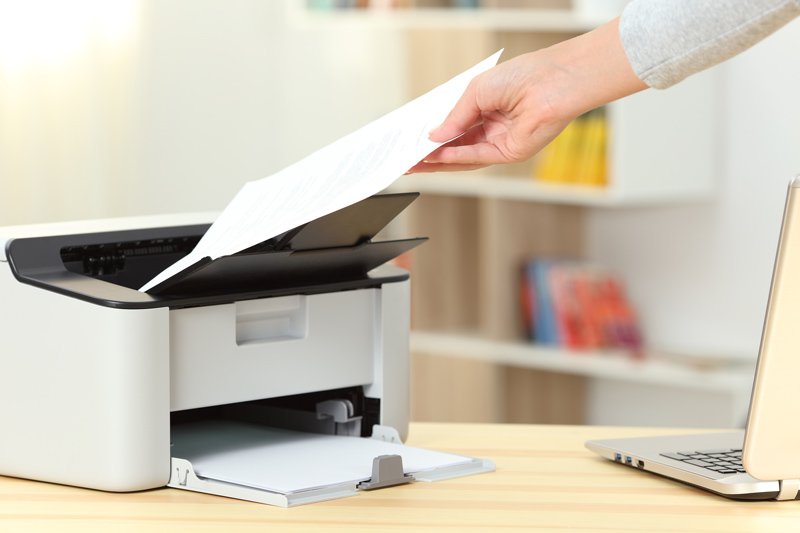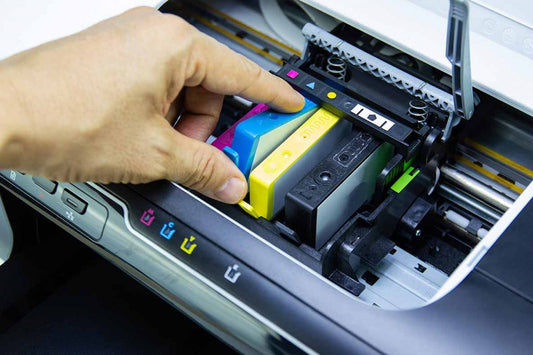More people than ever are working from home due to COVID-19. While being able to take meetings in pajama bottoms is a blessing to some, all the work done at home puts a strain on your personal equipment. Unless you’re one of the lucky ones allowed to take a company printer home, you probably find yourself using your home printer for work-related tasks. There isn’t anything inherently wrong with this, but it can get expensive. To help you save money, our printing experts have put together their top printing hacks for people working from home!
1. Avoid Annoying Paper Jams
Your printer flashing the ‘paper jam’ icon can ruin your day when you’re working from home if you don’t know how to stop it. The ‘paper jam’ icon often means a piece of paper has gotten stuck inside the device. When you send a job to print, your computer transmits the data to your printer. The printer then internally maps out how to lay the ink or toner down and begins feeding paper through to imprint the image or text. This can go wrong if you have low-quality paper, incorrectly loaded paper, or a poorly maintained machine.. Low-quality paper is prone to curling, sticking together, or crumpling as it moves through your device. Rather than force this damaged paper through, your machine stops when it runs into a problem. This causes a ‘jam’. You can open the device and gently pull it out most times without any issues. The same goes for the poorly loaded paper; you may find it bunches up and freezes the printer. A poorly maintained device with dirt, dust, or toner building upon the internal mechanics may jam even if your paper is perfect. The way to avoid any paper jam issues when working at home is to use mid- or high-quality paper, take care when loading it, and keep your printer well maintained with a professional maintenance regimen.
2. Keep Your Printer Maintained to Avoid Costly Repairs
You’ve likely heard the term ‘an ounce of prevention is worth a pound of cure’. This adage applies nicely to your printer! Maintaining your printer regularly with a professional inspection and cleaning will allow you to stop damage before it happens. Most of the issues associated with printers, such as jams, streaky printing, or poor color output are due to a poorly maintained machine. A maintenance program includes a detailed cleaning and thorough check for damaged parts. The cleaning tends to help prevent damage from happening in the first place, and then check for existing damage allows you to address any concerning areas before they break. This saves you money in the long run by letting you prepare ahead of time for repairs.
3. Good Printing Practices Start with Good Paper
Many people working from home are looking to cut costs wherever they can. When you see a great deal on cheap printer paper, why wouldn’t you take it? The reason to turn away from these too-good-to-be-true deals is that the cheap paper can damage your printer, costing you way more in repairs down the line. Cheap paper is low-quality paper. It drops fibers inside your machine, which clog it up, curls and causes jams, and often have trouble getting ink or toner to stick. All of these issues combine to be a deadly combination for your machine. One or two runs with cheap paper won’t kill it, but if you make a habit of cutting costs with the low-quality paper, you’ll end up damaging your printer. Use the mid-tier paper instead. You don’t need the high-gloss thick cover that costs a dollar per sheet, but a mid-tier paper will be a boon to your machine. Talk with your local printing expert to find an option that works for both your machine and your budget.
4. Swap Your Settings for Maximum Work-From-Home Printing
The ‘factory settings’ your printer starts with can be a bit of overkill, depending on what you’re doing. Printer manufacturers want you to be impressed with the quality! A fresh out of the box printer will likely have the highest print setting as a standard. If you don’t need this amazing quality for your work-from-home tasks, it can be an unnecessary expense. Start by going into your computer’s print settings. Change the DPI (dots per inch) to a lower number, around 72 or 300. 600 DPI is often standard for HQ photo printers, but if you’re doing text documents, the lower number will work fine. Also, swap your printer to ‘draft mode’ for documents. This prints in a lighter text, using less ink or toner.
For more common printing and other related tips, please contact Vegas Ink and Toner.




